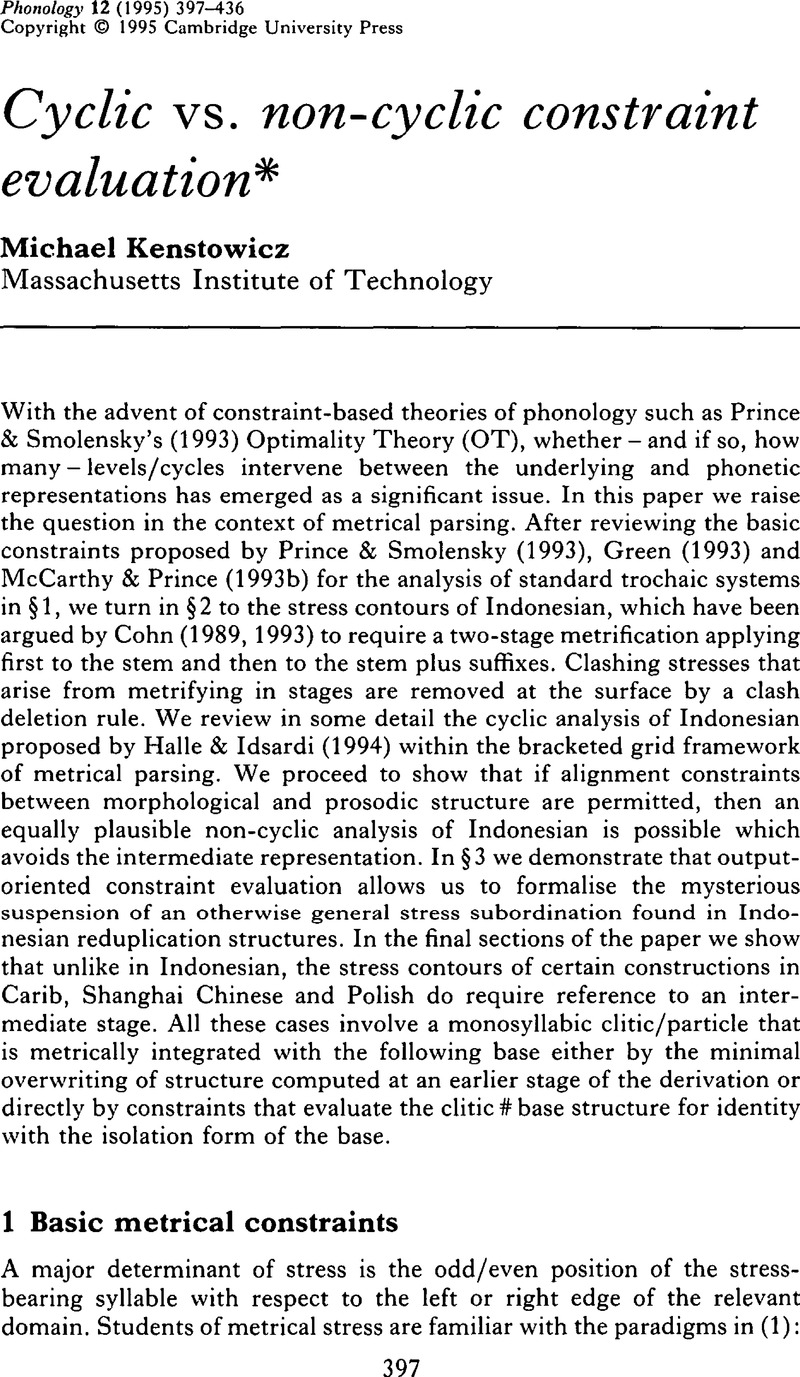Crossref Citations
This article has been cited by the following publications. This list is generated based on data provided by Crossref.
Kenstowicz, Michael
1996.
David Eberhard (1995). Mamaindé stress: the need for strata. (SIL Publications in Linguistics 122.) Dallas: Summer Institute of Linguistics and University of Texas at Arlington. Pp. ix + 159..
Phonology,
Vol. 13,
Issue. 3,
p.
450.
Alber, Birgit
and
Plag, Ingo
2001.
Epenthesis, deletion and the emergence of the optimal syllable in creole: the case of Sranan.
Lingua,
Vol. 111,
Issue. 11,
p.
811.
Benua, Laura
2004.
Optimality Theory in Phonology.
p.
417.
2004.
Optimality Theory in Phonology.
p.
581.
Ussishkin, Adam
2005.
A Fixed Prosodic Theory of Nonconcatenative Templaticmorphology.
Natural Language & Linguistic Theory,
Vol. 23,
Issue. 1,
p.
169.
Inkelas, Sharon
and
Zoll, Cheryl
2005.
Reduplication.
Kaisse, Ellen M.
2005.
Handbook of Word-Formation.
Vol. 64,
Issue. ,
p.
25.
Alber, Birgit
2005.
Clash, Lapse and Directionality.
Natural Language & Linguistic Theory,
Vol. 23,
Issue. 3,
p.
485.
Anttila, Arto
2006.
Variation and Opacity.
Natural Language & Linguistic Theory,
Vol. 24,
Issue. 4,
p.
893.
Hyde, Brett
2007.
Non-finality and weight-sensitivity.
Phonology,
Vol. 24,
Issue. 2,
p.
287.
McCarthy, John J.
2007.
What Is Optimality Theory?1.
Language and Linguistics Compass,
Vol. 1,
Issue. 4,
p.
260.
Kenstowicz, Michael
2007.
Salience and similarity in loanword adaptation: a case study from Fijian.
Language Sciences,
Vol. 29,
Issue. 2-3,
p.
316.
Burzio, Luigi
and
Tantalou, Niki
2007.
Modern Greek accent and faithfulness constraints in OT.
Lingua,
Vol. 117,
Issue. 6,
p.
1080.
Hyde, Brett
2007.
Issues in Banawá Prosody: Onset Sensitivity, Minimal Words, and Syllable Integrity.
Linguistic Inquiry,
Vol. 38,
Issue. 2,
p.
239.
Soderberg, Craig D.
and
Olson, Kenneth S.
2008.
Indonesian.
Journal of the International Phonetic Association,
Vol. 38,
Issue. 2,
p.
209.
Anttila, Arto
Fong, Vivienne
Beňuš, Štefan
and
Nycz, Jennifer
2008.
Variation and opacity in Singapore English consonant clusters.
Phonology,
Vol. 25,
Issue. 2,
p.
181.
Klein, Marc
and
Brandão de Carvalho, Joaquim
2010.
Opacité phonologique et liaison en français. De la sous-détermination de la variable à la motivation des variantes.
Langue française,
Vol. n°168,
Issue. 4,
p.
53.
김효영
2010.
A Study on Stress of Words with Stressed Suffixes.
The New Korean Journal of English Lnaguage & Literature,
Vol. 52,
Issue. 2,
p.
215.
Hyde, Brett
2011.
The Blackwell Companion to Phonology.
p.
1.
McCarthy, John J.
2011.
Tones and Features.
p.
195.



